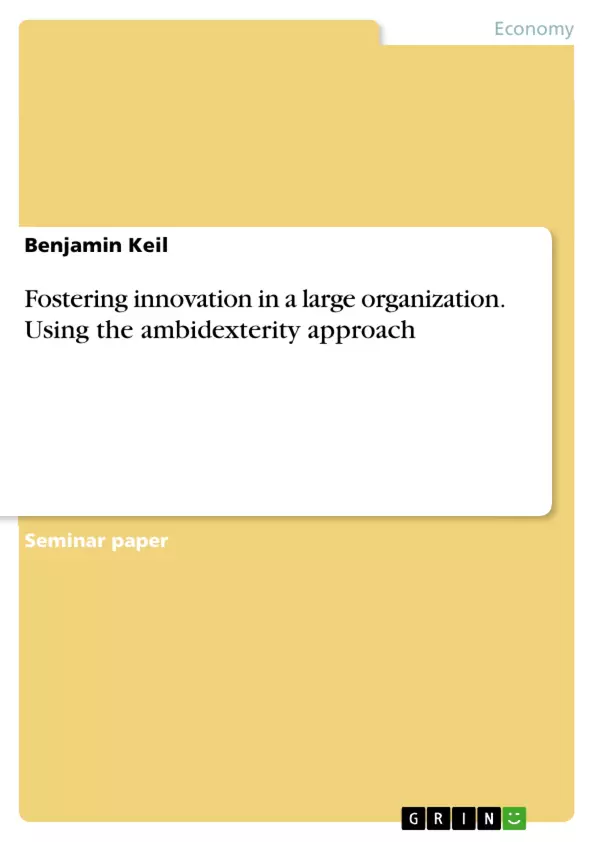Successful organizations often have developed several core competencies in order to outstand competitors. In a stable environment it is high likely that organizations only focus on further improving and developing the core competencies that help them to get into this comfortable situation. With this approach one could remain the market leader in such a relatively stable environment. This might have been the case in the past, but it is not the way we see the environment in the last centuries. The competitive business environment has fundamentally changed. With the globalization of markets, rapid technological change, shortening of product life cycles, and increasing aggressiveness of competitors, organizations have to face these changes (Volberda, 1996). It is not sufficient to only improve competencies one is already good at. Organizations must also explore in emerging business fields, test new products and experiment new procedures. Organizing a company in a way so that some employees are working on exploitation and others on exploration at the same is therefore a challenging balancing act. The approach of managing this balancing act of exploration and ex- ploitation is called organizational ambidexterity (O’Reilly & Tushman, 2004). This seminar paper will deal with this concept and answers the following question: How organizations use ambidextrous design to ensure innovation?
First, the concept organizational ambidexterity will be defined, and its five different literature streams presented. In addition to that, characteristics for organizations succeeding at this approach and possible implementation strategies will be discussed. Afterwards the methodological approach for the case study will be explained. The case study itself with a short company presentation of the Dr. Ing. h.c. F. Porsche AG and its findings cover chapter four. The conclusion in the last part will discuss the findings and give an overall summary with answering the research question.
Inhaltsverzeichnis (Table of Contents)
- 1 Introduction.
- 2 Organizational ambidexterity
- 2.1 Definition and conceptual background........
- 2.2 Prerequisites
- 2.3 Implementation strategies….........
- 3 Methodology
- 4 Case Study.
- 4.1 Company presentation – Dr. Ing. h.c. F. Porsche AG.
- 4.2 Findings.......
- 5 Conclusion........
- 5.1 Discussion of the findings.
- 5.2 Conclusion.......
Zielsetzung und Themenschwerpunkte (Objectives and Key Themes)
This seminar paper examines the concept of organizational ambidexterity and aims to answer the question of how organizations can leverage this approach to foster innovation. The paper delves into the definition and various conceptual streams surrounding organizational ambidexterity, explores prerequisites for its successful implementation, and discusses potential implementation strategies. The research methodology is outlined and applied in a case study focusing on Dr. Ing. h.c. F. Porsche AG.
- Organizational Ambidexterity
- Innovation and Growth
- Balancing Exploration and Exploitation
- Case Study: Dr. Ing. h.c. F. Porsche AG
- Implementation Strategies
Zusammenfassung der Kapitel (Chapter Summaries)
- Chapter 1 introduces the concept of organizational ambidexterity, emphasizing the necessity of navigating a dynamic environment characterized by globalization, rapid technological advancements, shortened product lifecycles, and intensified competition. It highlights the need for organizations to embrace both exploration (seeking new opportunities) and exploitation (enhancing existing capabilities) to remain competitive.
- Chapter 2 provides a detailed analysis of organizational ambidexterity, outlining its definition and the five distinct literature streams associated with it. It delves into the concept of exploitation and exploration, exploring their contrasting characteristics and implications for organizational learning, technological innovation, adaptation, strategic management, and organizational design.
- Chapter 3 outlines the methodology employed for the case study, setting the stage for the analysis of Dr. Ing. h.c. F. Porsche AG.
- Chapter 4 presents a concise overview of Dr. Ing. h.c. F. Porsche AG, followed by an examination of the findings regarding the company's ambidextrous approach.
Schlüsselwörter (Keywords)
Organizational ambidexterity, innovation, exploration, exploitation, strategic management, organizational design, technological innovation, case study, Dr. Ing. h.c. F. Porsche AG, implementation strategies, competitive advantage, adaptability, growth, and dynamic environment.
- Quote paper
- Benjamin Keil (Author), 2019, Fostering innovation in a large organization. Using the ambidexterity approach, Munich, GRIN Verlag, https://www.grin.com/document/505869



